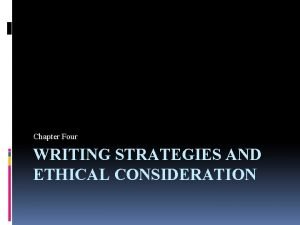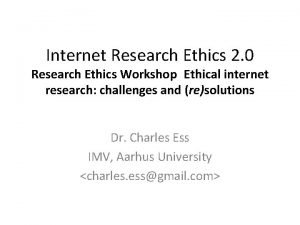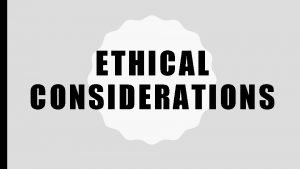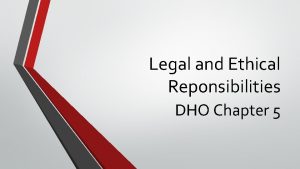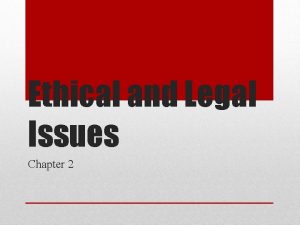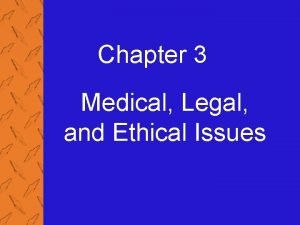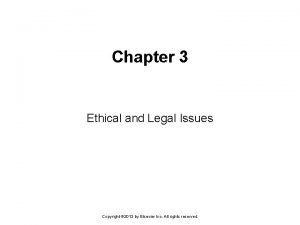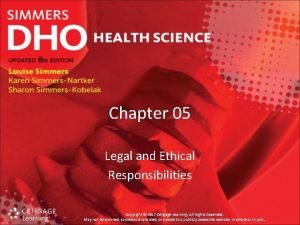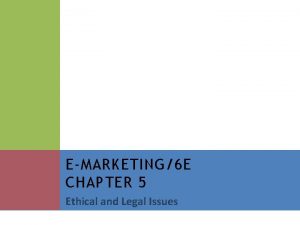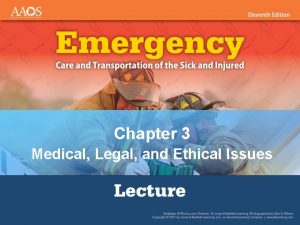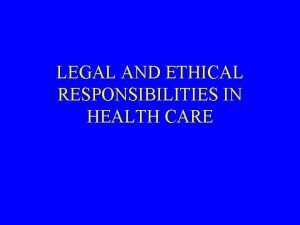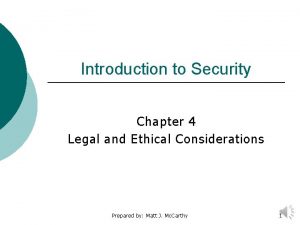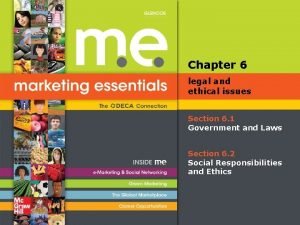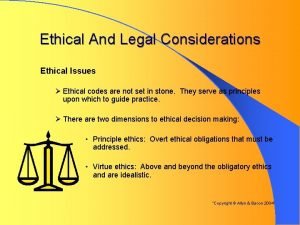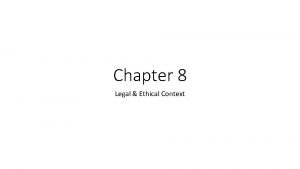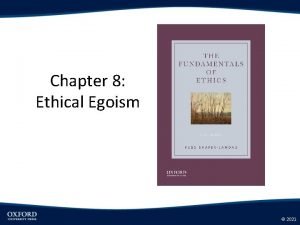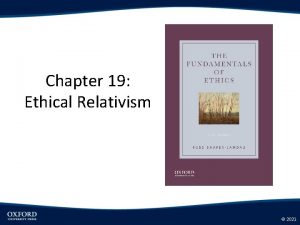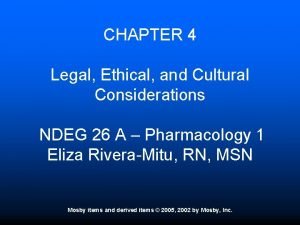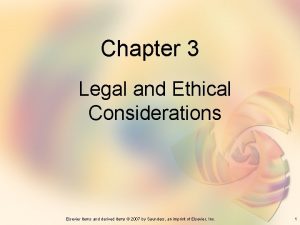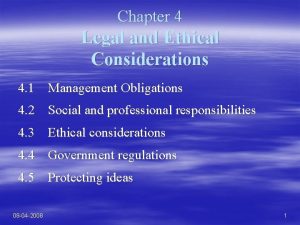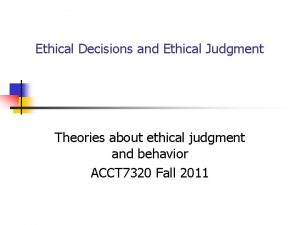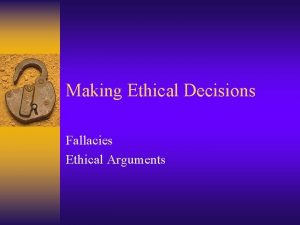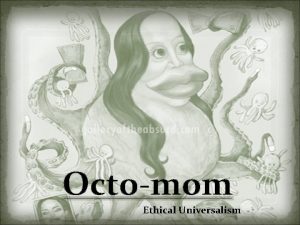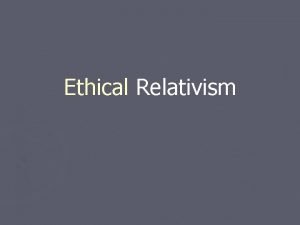Chapter 2 Understanding Ethical and Legal Considerations 2012














- Slides: 14

Chapter 2. Understanding Ethical and Legal Considerations © 2012 by Bedford/St. Martin's IN INTRODUCTION TO ETHICS

Definition: Ethics is the study of the principles of conduct that apply to an individual or a group. Chapter 2. Understanding Ethical and Legal Considerations © 2013 by Bedford/St. Martin's 2

Four Standard for Confronting Ethical Dilemmas • Rights—how are the individuals’ basic needs and welfare being effected? • Justice—how are the costs and benefits of an action or a policy distributed among a group? • Utility—what are the positive and negative effects that an action or a policy has on others? • Care—how does the action effect the relationships we have with other individuals? Chapter 2. Understanding Ethical and Legal Considerations 3

Your Ethical & Legal Obligations I. Obligations to your employer: • competence and diligence • generosity • honesty and candor • confidentiality • loyalty Chapter 2. Understanding Ethical and Legal Considerations 4

II. Obligations to the public: • Treat customers fairly • Provide a safe and effective product Chapter 2. Understanding Ethical and Legal Considerations 5

III. Obligations to the Environment: Know how your organization effects the environment IV. Obligations • to Copyright Holders: Know the “Fair Use” law and understand that copyright relates to the appropriate/fair use of a person’s intellectual property Bedford/St. Martin's •

Court Guidelines consider four factors in disputes over “fair use”: • the purpose and character of the use, especially whether the use is for profit • the nature and purpose of the copyrighted work • the amount and substantiality of the portion of the work used • the effect of the use on the potential market for the copyrighted work Chapter 2. Understanding Ethical and Legal Considerations 7

Dealing with Copyright Questions: • Abide by the fair-use concept: Don’t rely on excessive amounts of another source’s work. • Ask permission: Contact the source of the information for permission. • Cite your sources accurately: This fulfills your ethical obligation AND strengthens your writing, showing the reader the range of your research. • Consult legal counsel if you have questions. Chapter 2. Understanding Ethical and Legal Considerations 8

The Role of Corporate Culture in Ethical and Legal Conduct Organizations in which ethical values are promoted at all levels and where employees see that everyone lives up to the organization’s stated values – experience fewer ethical problems. 1. The organization’s leaders can set the right tone by living up to their commitment to ethical conduct. 2. Supervisors can set good examples and encourage ethical conduct. 3. Peers can support those employees who act ethically. 4. The organization can use informal communication to reinforce the formal policies, such as those presented in the company code of conduct. Chapter 2. Understanding Ethical and Legal Considerations 9

An effective code of conduct has three characteristics: 1. It protects the public rather than members of the organization or profession. 2. It is specific and comprehensive. 3. It is enforceable. Chapter 2. Understanding Ethical and Legal Considerations 10

Communicating Across Cultures: • They must not reinforce patterns of discrimination in product information, but they are not obligated to challenge the prevailing prejudice directly. • They must adhere to other countries’ federal and regional laws when exporting goods and services. Chapter 2. Understanding Ethical and Legal Considerations 11

Ten Principles for Ethical Communication: 1. Abide by copyright law. 2. Abide by the appropriate professional code of conduct. 3. Abide by your organization’s policy on social media. 4. Take advantage of your employer’s ethics resources. 5. Tell the truth. Chapter 2. Understanding Ethical and Legal Considerations 12

Ten Principles for Ethical Communication (cont. ): 6. Don’t mislead your readers. 7. Use design to highlight important ethical and legal information. 8. Be clear. 9. Avoid discriminatory language. 10. Acknowledge assistance from others. Chapter 2. Understanding Ethical and Legal Considerations 13

Avoid four common types of misleading technical communication: • false implications • exaggerations • legalistic constructions • euphemisms Chapter 2. Understanding Ethical and Legal Considerations © 2013 by Bedford/St. Martin's 14
 Writing strategies and ethical considerations
Writing strategies and ethical considerations Ethical consideration in experimental research sample
Ethical consideration in experimental research sample Appendices example in research paper
Appendices example in research paper Ethical considerations examples
Ethical considerations examples What is moral consideration in ethics
What is moral consideration in ethics Dho chapter 5 legal and ethical responsibilities
Dho chapter 5 legal and ethical responsibilities Ethical and legal issues chapter 2
Ethical and legal issues chapter 2 Chapter 3 medical legal and ethical issues
Chapter 3 medical legal and ethical issues Legal and ethical issues chapter 3
Legal and ethical issues chapter 3 Chapter 5 legal and ethical issues
Chapter 5 legal and ethical issues Legal and ethical issues chapter 5
Legal and ethical issues chapter 5 Chapter 3 medical legal and ethical issues
Chapter 3 medical legal and ethical issues Chapter 5 legal and ethical responsibilities answer key
Chapter 5 legal and ethical responsibilities answer key Chapter 4 legal and ethical responsibilities
Chapter 4 legal and ethical responsibilities Chapter 6 legal and ethical issues
Chapter 6 legal and ethical issues
